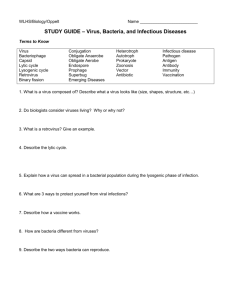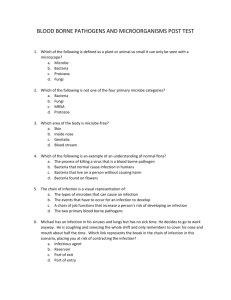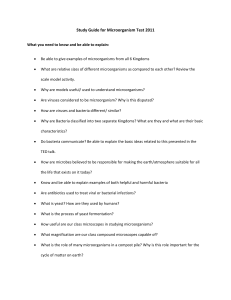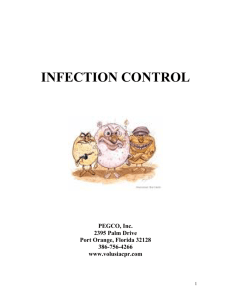The Cycle of Infection
advertisement
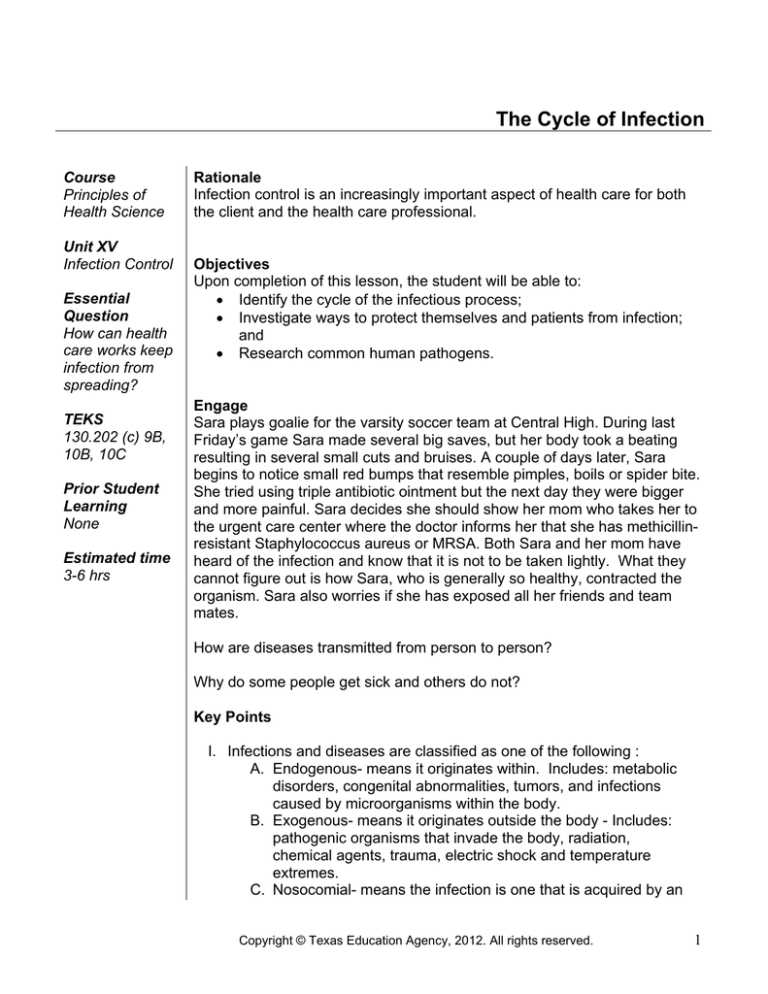
The Cycle of Infection Course Principles of Health Science Unit XV Infection Control Essential Question How can health care works keep infection from spreading? TEKS 130.202 (c) 9B, 10B, 10C Prior Student Learning None Estimated time 3-6 hrs Rationale Infection control is an increasingly important aspect of health care for both the client and the health care professional. Objectives Upon completion of this lesson, the student will be able to: Identify the cycle of the infectious process; Investigate ways to protect themselves and patients from infection; and Research common human pathogens. Engage Sara plays goalie for the varsity soccer team at Central High. During last Friday’s game Sara made several big saves, but her body took a beating resulting in several small cuts and bruises. A couple of days later, Sara begins to notice small red bumps that resemble pimples, boils or spider bite. She tried using triple antibiotic ointment but the next day they were bigger and more painful. Sara decides she should show her mom who takes her to the urgent care center where the doctor informs her that she has methicillinresistant Staphylococcus aureus or MRSA. Both Sara and her mom have heard of the infection and know that it is not to be taken lightly. What they cannot figure out is how Sara, who is generally so healthy, contracted the organism. Sara also worries if she has exposed all her friends and team mates. How are diseases transmitted from person to person? Why do some people get sick and others do not? Key Points I. Infections and diseases are classified as one of the following : A. Endogenous- means it originates within. Includes: metabolic disorders, congenital abnormalities, tumors, and infections caused by microorganisms within the body. B. Exogenous- means it originates outside the body - Includes: pathogenic organisms that invade the body, radiation, chemical agents, trauma, electric shock and temperature extremes. C. Nosocomial- means the infection is one that is acquired by an Copyright © Texas Education Agency, 2012. All rights reserved. 1 individual in a health care facility which is transmitted by health care workers to the patient. D. Opportunistic- means the infections are those that occur when the body’s defenses are weak. II. Infections are also classified as Aerobic or Anaerobic: A. Aerobic- means the organism requires oxygen to live. B. Anaerobic- means it lives and reproduces in the absences of oxygen. III. Infection cycle is well defined: A. Infective agent: Common pathogens include bacteria, viruses, funguses, rickettsiae, protozoa. B. Reservoir 1. Place where causative agent can live. 2. Common reservoirs include human body, animals, environment, and fomites or objects contaminated with infectious material that contains the pathogens. C. Portal of exit 1. Way for causative agent to escape from the reservoir. 2. Pathogens can leave the body through urine, feces, saliva, blood, tears, mucous discharge, sexual secretions, and draining wounds. D. Means of transmission 1. Pathogen must be transmitted to another reservoir or host where it can live. 2. Pathogen can be transmitted in different ways: a. Direct Contact 1. Person-to-person spread by physical contact. 2. Contact with the body secretions containing pathogen. b. Indirect contact 1. Pathogen is transmitted from contaminated substances (i.e. food, air, soil, insects, feces, clothing, instruments, and equipment). 2. Touching contaminated equipment. 3. Breathing in droplets carrying airborne pathogens. 4. Receiving the bite of an insect carrying pathogen. E. Portal of entry 1. Way to enter a new reservoir or host 2. Means of entry a. Breaks in the skin or mucous membrane b. Respiratory tract c. Digestive tract d. Genitourinary tract e. Circulatory system F. Susceptible host 1. Individual who can contract the disease. Copyright © Texas Education Agency, 2012. All rights reserved. 2 2. Humans may fight off causative agents and do not contract disease if: a. Defense mechanisms of body are intact. b. Immune system functioning. 3. Human becomes susceptible host in some instances a. Large numbers of the pathogen invade the body. b. Body defenses are weak. IV. The cycle of infection can be broken at any link of the chain A. The infectious agent can be neutralized or destroyed by Treatment. B. The reservoir host must maintain personal hygiene. C. The portal of exit is closed by the use of proper attire (gowns, gloves, other clothing), control of body secretions, and proper handwashing. D. The route of transmission is minimized through proper handwashing, disinfection and sterilization and proper disposal of contaminated materials. E. The portal of entry is blocked by asepsis, disinfection, and sterilization procedures. F. Host susceptibility is broken when the health and wellness of an individual is maintained. V. Microorganisms and Disease A. Microorganism: an organism that is too small to be seen by the human eye. 1. Fungi: simple plants such as molds and yeasts, some of which cause disease. 2. Protozoa: the only group of microorganisms classified as an animal. 3. Virus: microorganisms that are so small they cannot be seen with an ordinary light microscope. They are not destroyed by antibiotics. 4. Bacteria: microorganisms first seen under the microscope by Antoni van Leeuwenhoek in 1693. The classification is determined by the shape of the bacteria and whether it grows with or without oxygen. Only a few bacteria, such as staphylococcus and streptococcus cause disease. a. Aerobic bacteria: live and multiply in the presence of oxygen. b. Anaerobic bacteria: live and multiply without oxygen c. Cocci: round bacteria i. Staphylococci: round bacteria in clusters like grapes; cause boils, impetigo, and osteomyelitis ii.Streptococci: round bacteria arranged in chains; cause rheumatic fever, streptococcal pneumonia, and scarlet fever. iii. Diplococci: round bacteria arranged in pairs; Copyright © Texas Education Agency, 2012. All rights reserved. 3 cause gonorrhea and meningitis. d. Bacilla: rod shaped bacteria. e. Spirilla: shaped like spirals. 5. Rickettsiae: smaller than bacteria, barely visible under light microscope; cause typhus, Rocky Mountain spotted fever. B. Pathogen: a disease causing microorganism. VI. Asepsis is the absence of infection. A. Medical asepsis: practices and techniques that are designed to protect individuals from the spread of disease. 1. Antiseptic: substances that inhibit the growth of bacteria. Some of these substances can be used on the skin. 2. Disinfectant: substances or practices that cannot be used on the skin. This includes chemicals and boiling. 3. Sterile: absence of all microorganisms. B. Surgical asepsis: the use of sterile technique to handle equipment, maintain sterile fields, change dressings and dispose of contaminated materials without introducing harmful microorganisms. VII. Epidemiology: tracing the occurrence of health related events in society. A. Epidemiologist is a person who specializes in the study of outbreaks of diseases within a population group. 1. Endemic: refers to the ongoing presence of a disease within a population, group, or area. For example, the common cold is always present within a population. 2. Epidemic: is a sudden and widespread outbreak of a disease within a population, group or area. For example a sudden wide spread outbreak of measles is an epidemic. 3. Pandemic: refers to an outbreak of a disease occurring over a large geographic area, possibly worldwide. For example, AIDS is pandemic. Activity I. Create mobiles of various microorganisms. (Each should have identifying information telling about the microbe, what disease(s) it causes, epidemiology, treatment, and treatment success rate). II. Design a multimedia project that identifies a microorganism and its passage through the chain of infection. III. Research and investigate common human pathogens in small groups. Project Guidelines. Assessment Project rubric Oral presentation rubric Copyright © Texas Education Agency, 2012. All rights reserved. 4 Materials Art supplies. Internet accessibility Library resources Accommodations for Learning Differences For reinforcement, students will draw a poster showing the chain of infection and identify strategies to break the chain. For enrichment, students will research an infectious outbreak (such as the Ebola virus) that may be a threat to world health and present that information to the class. National and State Education Standards National Health Science Cluster Standards HLC06.01 Health care workers will understand the existing and potential hazards to patients, co-workers, and self. They will prevent injury or illness through safe work practices and follow health and safety policies and procedures. HLC06.02 Health care workers will understand the fundamentals of wellness and the prevention of disease processes. They will practice preventive health behaviors among their clients. TEKS 130.202(c)(9)(B) identify wellness strategies for the prevention of disease. 130.202(c)(10)(B) relate industry safety standards such as standard precautions, fire prevention, safety practices, and appropriate actions to emergency situations; and 130.202(c)(10)(C) identify safety practices in all aspects of the health science industry. Texas College and Career Readiness Standards English Language Arts I. A. 2. Generate ideas and gather information relevant to the topic and purpose, keeping careful records of outside sources. II. A. 4. Draw and support complex inferences form text to summarize, draw conclusions, and distinguish facts from simple assertions and opinions. V. A. 2. Explore a research topic. V. B. 1. Gather relevant sources. V. B. 2. Evaluate the validity and reliability of sources. V. B. 3. Synthesize and organize information effectively. Copyright © Texas Education Agency, 2012. All rights reserved. 5 V. B. 4. Use source material ethically. Social Studies IV B. 3. Gather, organize and display the results of data and research. Copyright © Texas Education Agency, 2012. All rights reserved. 6 Project Guidelines Each group investigates one to three diseases to determine what type of pathogens (virus? bacteria? etc.) cause the diseases. 1) Polio 11) Herpes 2) Measles 12) Mumps 3) Candidiasis 13) Chicken pox 4) Tuberculosis 14) Gonorrhea 5) Mononucleosis 15) Syphilis 6) AIDS 16) Hepatitis 7) Malaria 17) Athlete’s foot 8) Amebic Dysentery 18) Giardasis 9) Trichinosis 19) Thrush 10) Encephalitis 20) Ringworm Find out who is at risk and how the disease is transmitted. Include information about the symptoms and treatments and the treatment success rate. Report your findings to the class. Copyright © Texas Education Agency, 2012. All rights reserved. 7 Oral Presentation Rubric Student: _______________________ Date: ___________________________ Scoring criteria 4. 3. Excellent Good 2. Needs 1. Needs Some Much N/A Improvement Improvement Clearly and effectively communicates the main idea or theme. Presenter is self-confident and clearly expresses ideas. Presenter answers questions with well thought out responses. Holds audience attention and maintains eye contact. Visual aids are clear and add to the presentation. NOTE: N/A represents a response to the performance which is "not appropriate." Copyright © Texas Education Agency, 2012. All rights reserved. 8 Project Rubric Student: ________________________Date: ___________________________ Scoring criteria 4. 3. Excellent Good 2. Needs 1. Needs Some Much N/A Improvement Improvement Clearly/effectively communicates the main idea or theme. Reflects application of critical thinking. Information clearly provided in an organized and thoughtful manner. Strong examples used to describe the theme or objective. Illustrations follow a logical reasoning. Each image and font size is legible to entire audience. No spelling, grammatical or punctuation errors. NOTE: N/A represents a response to the performance which is "not appropriate." Copyright © Texas Education Agency, 2012. All rights reserved. 9


